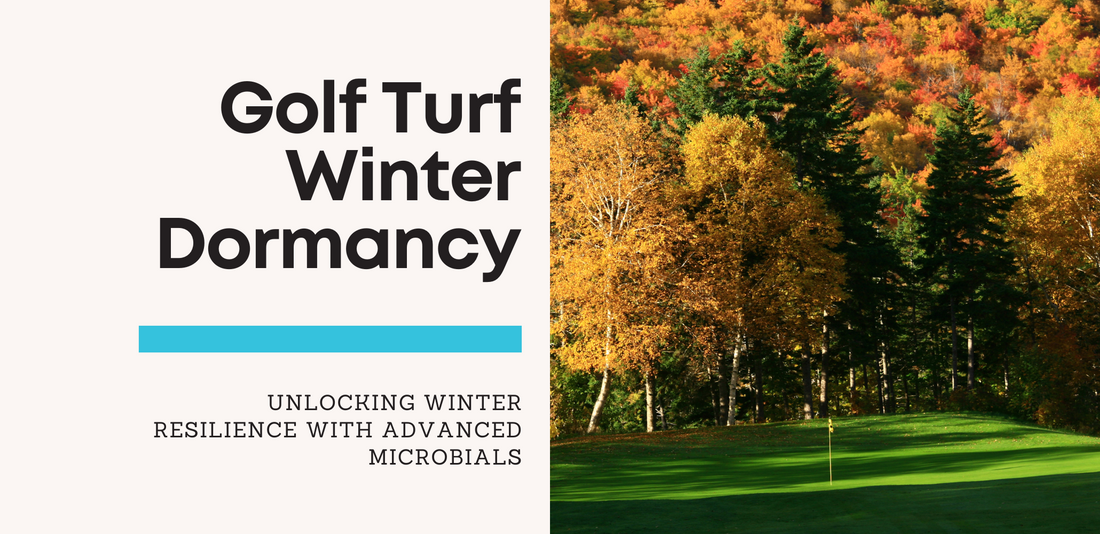
Golf Turf Winter Dormancy: Unlocking Winter Resilience with Advanced Microbials
This blog can be found at the new En-Turf website: https://www.enturf.com/post/golf-turf-winter-dormancy-unlocking-winter-resilience-with-advanced-microbials
By Ashley Kim MHI, Product Manager
Discover how organic microbial inoculants enhance your golf turf's winter resilience. Look at how beneficial PGPBs are to fortify turf against stress, enhance nutrient uptake, and promote vibrant spring green-up.
In this article, we’ll delve into:
- The endosphere and plant growth-promoting bacteria
- microbes for resilience to winter dormancy
- sustainable strategies for winter resilience
As the vibrant greens of summer fade into the crisp hues of autumn, golf course managers and superintendents face the annual challenge of maintaining lush, green turfgrass throughout the winter. Winter dormancy, a natural part of the turfgrass life cycle, often leaves golf courses with straw-like lawns. Traditionally, turf management has heavily relied on fertilizers and fungicides to combat winterkill and keep turf healthy during dormancy. However, microbial inoculants are an innovative and sustainable alternative. Fortification with these beneficial microorganisms can significantly improve growth, stress resistance, and long-term turf vitality, making it easier to achieve a vibrant spring green-up after the harsh winter.
Nature's Interior Network: The Endosphere and Plant Growth-Promoting Bacteria
Hidden within the tissues of grass and plants lies an intricate ecosystem known as the endosphere. Plant growth-promoting bacteria (PGPB), also known as bacterial endophytes, have coevolved with plants in the endosphere. PGPBs reside in various plant parts, from roots to tillers and stems, functioning as an interior network for plants. This internal network of beneficial bacteria mediates molecular processes essential for plant health, including disease suppression, nutrient breakdown and accessibility, and stress resistance. Similarly, soil-residing PGPBs secrete a variety of metabolites and hormones that increase nutrient bioavailability through mineral solubilization [1].
Grass encounters constant stress from foot traffic, herbivores, diseases, drought, salt, and heat. As a result of stress, plant ethylene levels increase, leading to reduced growth and immune system functioning. PGPBs support tolerance to these stressors by producing an enzyme called ACC deaminase that breaks down the stress hormone ethylene. As a result of increased pollution, antibiotics in waterways, and pesticide use over time, natural PGPBs have depleted from the soil–they are now a limited resource for crops and grass. However, when fortified with PGPBs through inoculation, the natural probiotic microbiome is reestablished, allowing plants to grow and flourish even when faced with stressors.

Harnessing Microbes for Resilience to Winter Dormancy
Winter poses unique challenges for golf turf, essentially subjecting it to a form of drought and prompting grass dormancy. However, even during this dormant period, grass continues to grow underground, albeit at a slower pace. During winter dormancy, grass is susceptible to drought and salt stress; and factors such as frozen soil and limited snow cover. However, fortifying your turf with beneficial PGPBs enables growth despite the winter stress, unlocking access to dormant nutrients, such as atmospheric nitrogen converted into ammonia for plant use. PGPB treatments facilitate crucial changes: roots extend to find more water, stolons and rhizomes/roots multiply, and crowns store sugars in preparation for the upcoming winter. In essence, PGPBs serve as resilience boosters, helping golf course turf thrive through winter's trials and emerge stronger for the coming spring.
Recent research has shed light on the remarkable benefits of microbial inoculants for golf turf:
- Enhanced Growth: In a 2020 study by Lopes et al., grass tillers treated with PGPB showed a 36% increase in growth compared to untreated counterparts [2].
- Drought Resilience: A 2023 study by Errickson et al. found that PGPB-producing ACC deaminase not only improved drought recovery but also promoted growth during drought conditions, resulting in rapid regrowth [3].
- Disease Resistance: A 2023 study by Kaur et al. demonstrated the effects of microbial inoculants in combating turfgrass diseases such as Dollar Spot [4].
Spring green-up is a critical phase for turfgrass health, predominantly dependent on nitrogen reserves from the previous year, as grass cannot utilize fertilizers during the initial two weeks. Research by Sermons et al. reveals that an astounding 80% of fertilizers applied in the initial 10 to 14 days of spring green-up wash away, unused by the grass [5]. Maximizing nitrogen storage, root length, numbers, stolon growth, and crown carbohydrate reserves is imperative. PGPB fortification, ideally year-round but minimally in the fall, is an effective strategy to prepare turf for winter dormancy. This strategy promotes ethylene regulation, nutrient partitioning, and structural adaptations, bolstering winter resilience by channeling resources into growth rather than stress resistance and tapping into atmospheric nitrogen within the soil.
The End Game: Sustainable Strategies for Winter Resilience
Incorporating microbial inoculants into turf management allows golf course managers and superintendents to bolster winter resilience and champion sustainability. These solutions reduce plant stress, enhance nutrient availability, stimulate growth, and fortify overall turf vitality, resulting in greener, healthier, and winter-resilient greens that shine year-round.
To learn more about our approach to winter resilience, you can click here.
References
- Poria V, Dębiec-Andrzejewska K, Fiodor A, et al. Plant Growth-Promoting Bacteria (PGPB) integrated phytotechnology: A sustainable approach for remediation of marginal lands. Frontiers in Plant Science. 2022;13. Accessed September 13, 2023. https://www.frontiersin.org/articles/10.3389/fpls.2022.999866
- Lopes C, Carvalho C, Nuno A, et al. Nitrogen in Shoots, Number of Tillers, Biomass Yield and Nutritive Value of Zuri Guinea Grass Inoculated with Plant-Growth Promoting Bacteria. 2020;8:437. doi:10.31686/ijier.vol8.iss5.2360
- Errickson W, Zhang N, Huang B. Promotive effects of endophytic rhizobacteria on tiller and root growth in creeping bentgrass during drought stress and post-stress recovery involving regulation of hormone and sugar metabolism. Crop Science. 2023;63(4):2583-2593. doi:10.1002/csc2.21017
- Kaur C, Fidanza M, Ervin E, Bais HP. SpoA-Dependent antifungal activity of a plant growth promoting rhizobacteria Bacillus subtilis strain UD1022 against the dollar spot pathogen (Clarireedia jacksonii). Biological Control. 2023;184:105284. doi:10.1016/j.biocontrol.2023.105284
- Sermons SM, Wherley BG, Zhang C, Bowman DC, Rufty TW. The role of internal and external nitrogen pools in bermudagrass growth during spring emergence from dormancy. Journal of Plant Nutrition. 2017;40(10):1404-1416. doi:10.1080/01904167.2016.1264424
Keywords: Golf turf management, Winter dormancy resilience, Microbial inoculants, Biostimulants for turfgrass, Plant growth-promoting bacteria, PGPB, Sustainable turf strategies, Turf disease resistance, drought, resilience, Sustainable, turf care, Nitrogen
